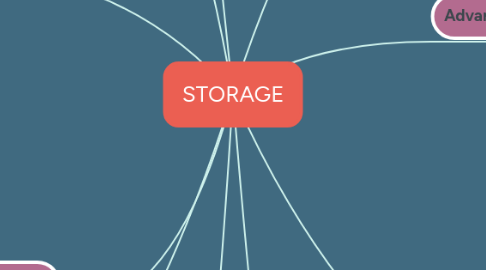
1. STORAGE MEDIUM
1.1. a physical material on which a computer keeps data, information, programs, and applications
2. CLOUD STORAGE
2.1. Is an Internet service that provides storage to computer or mobile device users
3. FLASH MEMORY
3.1. Memory Card
3.1.1. a removable flash memory storage device that you insert and remove from a slot in a computer, mobile device, or card reader/writer
3.1.2. Example
3.1.2.1. SDHC
3.1.2.2. SDXC
3.1.2.3. miniSD
3.1.2.4. microSDHC
3.1.2.5. microSDXC
3.2. USB Flash Drive
3.2.1. plug into a USB port on a computer or mobile device
4. SOLID STATE DRIVE(SSD)
4.1. A flash memory storage device that contains its own processor to manage it storage.
4.2. Advantages
4.2.1. Faster access time
4.2.2. Faster transfer rates
4.2.3. Quieter operation
4.2.4. More durable
4.2.5. Lighter weight
5. a hardware that records and/or retrieves items to and from storage media
5.1. Reading
5.1.1. Is the process of transferring items from a storage medium into memory.
5.2. Writing
5.2.1. Is the process of transferring items from memory to a storage medium.
6. ENTERPRISE STORAGE
6.1. Enterprise hardware allows large organizations to manage and store data and information using devices intended for heavy use, maximum efficiency, and maximum availability
6.2. Network Attached Storage (NAS)
6.2.1. A server that is placed on a network with the sole purpose of providing storage to users, computers, and devices attached to the network.
6.3. Storage Area Network (SAN)
6.3.1. A high-speed network with the sole purpose of providing storage to other attached servers
6.4. Tape
6.4.1. A magnetically coated ribbon of plastic capable of storing large amounts of data and information
6.4.2. A tape drive reads and writes data and information on a magnetic tape
7. Advantages
7.1. Less power consumption
7.2. Less heat generated
7.3. Longer life
7.4. Defragmentation not required
8. HARD DISC DRIVE(HDD)
8.1. Capacity determined by
8.1.1. Number of number of platters the hard disk contains.
8.1.2. Position of the magnetic coating on the platters.
8.1.3. Whether the disk uses longitudinal or perpendicular recording.
8.1.4. Density
8.2. Characteristic
8.2.1. Tracks
8.2.2. Sectors
8.2.3. Platters
8.2.4. Form Factor
8.2.5. Read/write Head
8.2.6. Revolutions per minute
9. OPTICAL DISC
9.1. A disc consists of a flat, round, portable disc made of metal, plastic, and lacquer that is written and read by a laser.
9.2. Commonly store items in a single track that spirals from the center of the disc to the edge of the disc.
9.3. Track is divided into evenly sized sectors.
9.4. Typically stores data, instructions, and information in a single track that spirals from the center of the disc to the edge of the disc
9.5. Example
9.5.1. CD-ROM
9.5.1.1. Can be read from but not written to (Single-session disc)
9.5.2. CD-R
9.5.2.1. An optical disc on which users can write once, but not erase.
9.5.3. CD-RW
9.5.3.1. An erasable multi-session disc.
9.5.4. DVD-ROM
9.5.4.1. A high-capacity optical disc on which users can read but not written on or erase.
9.5.5. DVD-R/DVD+R
9.5.5.1. Competing DVD
9.5.5.2. Recordable WORMformats, on which users can write once but not erase.
9.5.6. DVD-RW,DVD+R,DVD+RAM
9.5.6.1. Competing DVD
9.5.6.2. Rewritable formats that users can write on multiple times.
10. OTHER TYPES OF STORAGE
10.1. Magnetic Stripe Card -has a magnetic stripe that contains information
10.2. Smart Card -stores data on an integrated circuit embedded in the card
10.3. RFID tag
10.3.1. consists of an antenna and a memory chip that contains the information to be transmitted via radio waves
10.3.2. An RFID reader reads the radio signal and transfers the information to a computer or computing device
10.3.3. An RFID reader reads the radio signal and transfers the information to a computer or computing device
10.4. NFC
10.4.1. An NFC-enabled device contains an NFC chip.
10.4.2. An NFC tag contains a chip and an antenna that contains information to be transmitted.
10.4.3. Most NFC tags are self-adhesive.
